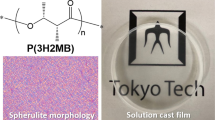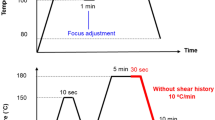Abstract
Novel polyhydroxyalkanoate (PHA) copolymers of (2R,3R)-3-hydroxy-2-methylbutyrate (3H2MB) and (R)-3-hydroxybutyrate (3HB) [P(3H2MB-co-3HB)] with various comonomer compositions were biosynthesized using recombinant Escherichia coli LSBJ. Furthermore, solvent fractionation of biosynthesized P(24 mol% 3H2MB-co-3HB) was performed to obtain copolymers with narrow comonomer-unit compositional distributions. The melting temperature (Tm) of P(3H2MB-co-3HB) as a function of the comonomer content indicated isodimorphism of the copolymer. The fast crystallization behavior of P(3H2MB) was maintained even when it was copolymerized with 3HB. The P(80 mol% 3H2MB-co-3HB) copolymer, with a Tm close to that of P(3HB), exhibited faster crystallization behavior than the P(3HB) homopolymer. Therefore, copolymerization of 3H2MB and 3HB is valuable for the design of new PHA materials with desirable properties.
This is a preview of subscription content, access via your institution
Access options
Subscribe to this journal
Receive 12 print issues and online access
$259.00 per year
only $21.58 per issue
Buy this article
- Purchase on Springer Link
- Instant access to full article PDF
Prices may be subject to local taxes which are calculated during checkout





Similar content being viewed by others
References
Sudesh K, Abe H, Doi Y. Synthesis, structure and properties of polyhydroxyalkanoates: biological polyesters. Prog Polym Sci. 2000;25:1503–55.
Rehm BHA. Biogenesis of microbial polyhydroxyalkanoate granules: a platform technology for the production of tailor-made bioparticles. Curr Issues Mol Biol. 2007;9:41–62.
Tsuge T. Metabolic improvements and use of inexpensive carbon sources in microbial production of polyhydroxyalkanoates. J Biosci Bioeng. 2002;94:579–84.
Satoh H, Mino T, Matsuo T. PHA production by activated sludge. Int J Biol Macromol. 1999;25:105–9.
Dai Y, Lambert L, Yuan Z, Keller J. Characterization of polyhydroxyalkanoate copolymer with controllable four-monomer composition. J Biotechnol. 2008;134:137–45.
Rand JM, Gordon GC, Mehrer CR, Pfleger BF. Genome sequence and analysis of Escherichia coli production strain LS5218. Metab Eng Commun. 2017;5:78–83.
Watanabe Y, Ishizuka K, Furutate S, Abe H, Tsuge T. Biosynthesis and characterization of novel poly(3-hydroxybutyrate-co-3-hydroxy-2-methylbutyrate): thermal behavior associated with α-carbon methylation. RSC Adv. 2015;5:58679–85.
Tappel RC, Wang Q, Nomura CT. Precise control of repeating unit composition in biodegradable poly(3-hydroxyalkanoate) polymers synthesized in Escherichia coli. J Biosci Bioeng. 2012;114:480–6.
Furutate S, Nakazaki H, Maejima K, Hiroe A, Abe H, Tsuge T. Biosynthesis and characterization of novel polyhydroxyalkanoate copolymers consisting of 3-hydroxy-2-methylbutyrate and 3-hydroxyhexanoate. J Polym Res. 2017;24:221.
Furutate S, Kamoi J, Nomura CT, Taguchi S, Abe H, Tsuge T. Superior thermal stability and fast crystallization behavior of a novel, biodegradable α-methylated bacterial polyester. NPG Asia Mater. 2021;13:31–42.
Ushimaru K, Watanabe Y, Hiroe A, Tsuge T. A single-nucleotide substitution in phasin gene leads to enhanced accumulation of polyhydroxyalkanoate (PHA) in Escherichia coli harboring Aeromonas caviae PHA biosynthetic operon. J Gen Appl Microbiol. 2015;61:63–66.
Tanadchangsaeng N, Tsuge T, Abe H. Comonomer compositional distribution, physical properties, and enzymatic degradability of bacterial poly(3-hydroxybutyrate-co-3-hydroxy-4-methylvalerate) copolyesters. Biomacromolecules. 2010;11:1615–22.
Mizuno S, Hiroe A, Fukui T, Abe H, Tsuge T. Fractionation and thermal characteristics of biosynthesized polyhydoxyalkanoates bearing aromatic groups as side chains. Polym J. 2017;49:557–65.
Kamiya N, Yamamoto Y, Inoue Y, Chujo R, Doi Y. Microstructure of bacterially synthesized poly(3-hydroxybutyrate-co-3-hydroxyvalerate). Macromolecules. 1989;22:1676–82.
Tsuge T, Watanabe S, Shimada D, Abe H, Doi Y, Taguchi S. Combination of N149S and D171G mutations in Aeromonas caviae polyhydroxyalkanoate synthase and impact on polyhydroxyalkanoate biosynthesis. FEMS Microbiol Lett. 2007;277:217–22.
Tsuge T. Fundamental factors determining the molecular weight of polyhydroxyalkanoate during biosynthesis. Polym J. 2016;48:1051–7.
Bloembergen S, Holden DA, Bluhm TL, Hamer GK, Marchessault RH. Isodimorphism in synthetic poly(β-hydroxybutyrate-co-β-hydroxyvalerate): stereoregular copolyesters for racemic β-lactones. Macromolecules. 1989;22:1663–9.
Bluhm TL, Hamer GK, Marchessault RH, Fyfe CA, Veregin RP. Isodimorphism in bacterial poly(β-hydroxybutyrate-co-β-hydroxyvalerate). Macromolecules. 1986;19:2871–6.
Füchtenbusch B, Fabritius D, Steinbüchel A. Incorporation of 2-methyl-3-hydroxybutyric acid into polyhydroxyalkanoic acids by axenic cultures in defined media. FEMS Microbiol Lett. 1996;138:153–60.
Dong H, Liffland S, Hillmyer MA, Chang MCY. Engineering in vivo production of α‑branched polyesters. J Am Chem Soc. 2019;141:16877–83.
Doi Y, Kitamura S, Abe H. Microbial synthesis and characterization of poly(3-hydroxybutyrate-co-3-hydroxyhexanoate). Macromolecules. 1995;28:4822–6.
Feng L, Watanabe T, Wang Y, Kichise T, Fukuchi T, Chen GQ, et al. Studies on comonomer compositional distribution of bacterial poly(3-hydroxybutyrate-co-3-hydroxyhexanoate) s and thermal characteristics of their factions. Biomacromolecules. 2002;3:1071–7.
Acknowledgements
We would like to thank Prof. Christopher T. Nomura (University of Idaho) and Prof. Seiichi Taguchi (Tokyo University of Agriculture) for kindly gifting the E. coli strains LSBJ and PCT, respectively. This study was supported by a Grant-in-Aid for Scientific Research (KAKENHI, 21H03640).
Author information
Authors and Affiliations
Contributions
SF and TT designed the experiments. SF performed the experiments and analyzed the data. All the authors discussed the results and commented on the manuscript.
Corresponding author
Ethics declarations
Conflict of interest
The authors declare no competing interests.
Additional information
Publisher’s note Springer Nature remains neutral with regard to jurisdictional claims in published maps and institutional affiliations.
Supplementary information
Rights and permissions
About this article
Cite this article
Furutate, S., Abe, H. & Tsuge, T. Thermal properties of poly(3-hydroxy-2-methylbutyrate-co-3-hydroxybutyrate) copolymers with narrow comonomer-unit compositional distributions. Polym J 53, 1451–1457 (2021). https://doi.org/10.1038/s41428-021-00545-4
Received:
Revised:
Accepted:
Published:
Issue Date:
DOI: https://doi.org/10.1038/s41428-021-00545-4
This article is cited by
-
Nature-inspired methylated polyhydroxybutyrates from C1 and C4 feedstocks
Nature Chemistry (2023)



